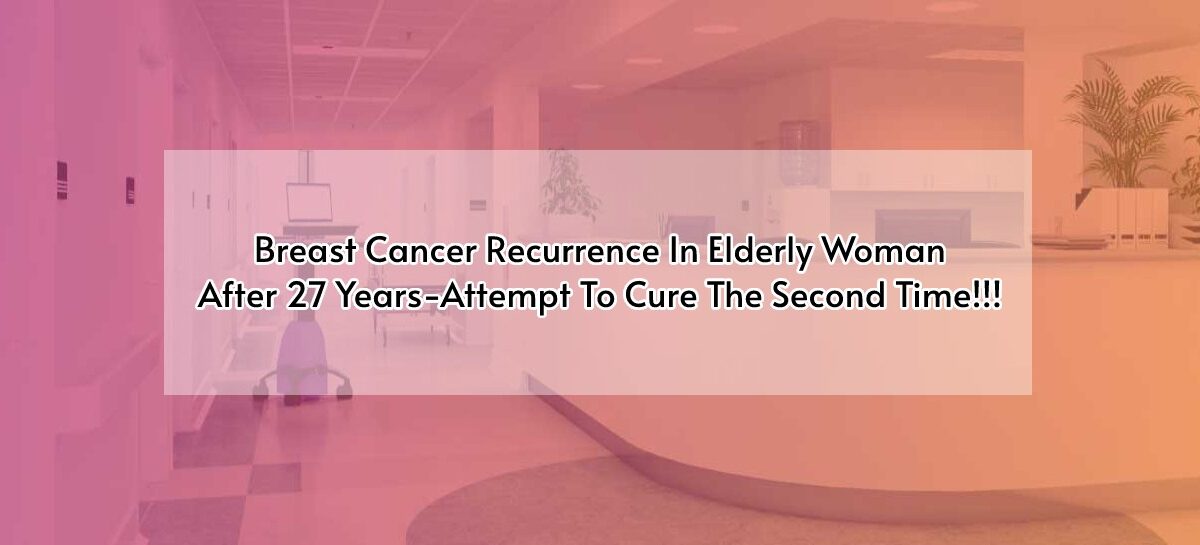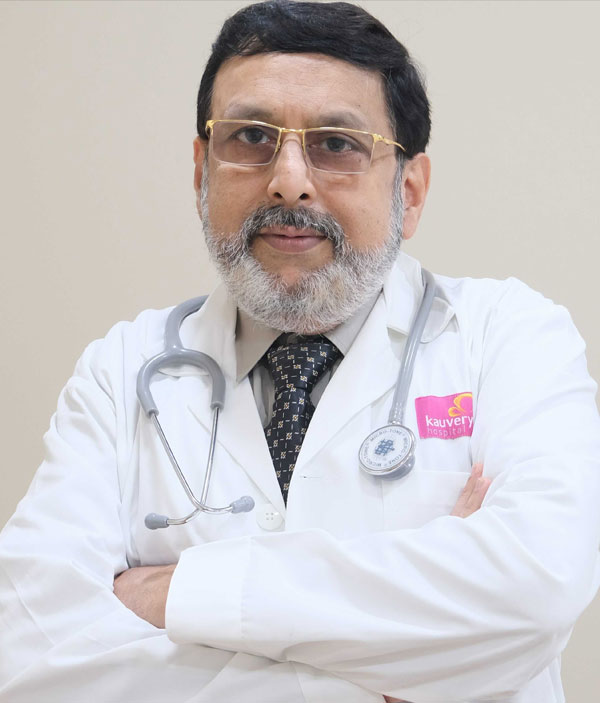Priya Philip1,*, AN. Aswin2, Andrew C. Fenn2, AN. Vaidhyswaran3
1Registrar, Department of Radiation Oncology, Kauvery Hospital, Chennai, India
2Consultant, Department of Radiation Oncology, Kauvery Hospital, Chennai, India
3Senior Consultant and Director, Department of Radiation Oncology, Kauvery Hospital, Chennai, India
INTRODUCTION
Carcinoma breast is the most common malignancy in women and a five year relative survival rate is high when all stages are combined, owing to successful screening programs and early detection. [1] About 74% of the newly diagnosed breast cancers are in stage I-III and are estrogen receptor positive. They tend to recur even at a later period. About 50% of the recurrences occur after five years of the initial diagnosis. The current National Comprehensive Cancer Network guidelines recommend considering adjuvant endocrine therapy for all invasive, ER-positive breast cancers unless specific contraindications exist.[2]
CASE REPORT
The 86 years old elderly woman in our case had carcinoma of the left breast 27 years ago. She had locally advanced carcinoma of the left breast and was treated at an outside hospital. She received three cycles of neoadjuvant chemotherapy and was taken up for left-sided modified radical mastectomy. She had three cycles of adjuvant chemotherapy and received hormonal therapy for three years. She was asymptomatic since then. In January she came to the outpatient department with multiple nodules over the left chest wall. On clinical examination, there were multiple nodules of varying size in the chest wall along the mastectomy scar. The right breast was normal. There was no axillary or supra clavicular lymphadenopathy bilaterally. X-ray mammogram with ultrasound screening revealed five to six ill defined hypoechoic nodules, the largest measuring 13x6mm, mainly to the medial end of the scar. Some of the nodules show cystic changes. A Doppler study showed minimal intranodular vascularity. A few prominent axillary lymphadenopathies bilaterally with preserved fatty hilum were observed. FDG PET-CT whole-body scan showed multiple metabolically active soft tissue nodular lesions in the anterior left chest wall, with a maximum size of 17x13mm (SUV max=11). Bilateral upper and lower para tracheal and bilateral hilar lymph nodes were present, along with suspicious inflammatory lymphadenopathy. Right breast and bilateral axillae-normal. The impression was of a highly suspicious local recurrence.

She underwent a biopsy and wide local excision of the lesions. Histopathological examinations revealed grade II mucinous carcinoma. The size of the tumour was 2.3×1.5×0.8cm. The skin was uninvolved by malignancy. The superior, inferior, anterior, lateral and deep resected margins were free of tumours. Lymphovascular invasion was present and perineural invasion was absent. Immunohistochemistry showed ER positivity, PR positivity, Ki-67-20% and Her-2-neu-negative.
Adjuvant radiotherapy to the left chest wall was planned. Using appropriate immobilization and a thoracic aquaplast device she underwent planning CT. After treatment planning, she was taken up for external beam radiotherapy in a Linear Accelerator using Image Guided Radiotherapy (IGRT). She received a total dose of 50Gy in 25 fractions to the planning target volume using 6MV photons. She completed the treatment without much morbidity and her tolerance to the treatment was good. Considering her advanced age, she was considered unfit for chemotherapy. Since she has hormone-positive breast cancer, she was advised adjuvant endocrine therapy with Letrozole tablets. She is on regular follow-up and is doing well.
DISCUSSION
About 74% of the newly diagnosed breast cancers are in stage I-III and hormone positive. The clinical behaviour of ER-positive and ER-negative cancers are different. When the patterns of disease recurrence were studied and compared between estrogen positive and estrogen negative cases, the rates of recurrence were significantly higher in patients with ER-negative status for the first two years of follow-up, but not thereafter. ER-negative cancers tend to recur in viscera and soft tissue, but ER-positive cases show recurrence locally and in bone[3]. ER-positive cancers can have late recurrences. 50% of recurrences occur after 5 years. In literature recurrent disease as late as 30 years after the initial disease has been recorded. The most important factors that define the risk for recurrence, both early and late, are tumor size, nodal status, and histologic grade. In a recent meta-analysis of patients with ER-positive T1 disease, the risk of distant recurrence after 5 years of endocrine therapy was 13% with no lymph node involvement, 20% with one to three positive nodes, and 34% with four to nine nodes. Among T2 tumors, the risks were 19%, 26%, and 41%, respectively. Considering the impact of grade among patients with T1 N0 disease, the risk of distant recurrence was 10% for low-grade, 13% for intermediate-grade, and 17% for high-grade disease.10 These results illustrate that grade, tumor size, and nodal status are independent variables and carry different prognostic weights, with the number of involved nodes having the strongest impact and grade having the weakest.[2].
ER /PR positive patients are advised to take adjuvant endocrine therapy. Many studies prove that prolonging the therapy for more than five years improves disease-free survival(DFS). The duration of tamoxifen treatment for 5 years vs 10 years was compared in the ATLAS trial.[4] The ATLAS (Adjuvant Tamoxifen: Longer Against Shorter) trial (N = 6,846) demonstrated that extending tamoxifen to 10 years significantly reduced breast cancer recurrence (617 v 711 events; P = .002), breast cancer mortality (331 v 397 deaths; P = .01), and overall mortality (639 v 722 deaths; P = .01). The MA.17R trial (N = 1,918) showed that treatment with letrozole after 5 years of tamoxifen therapy improved DFS (95% v 91%; P = .01)[5]. The NSABP’s (National Surgical Adjuvant Breast and Bowel Project) B-42 trial (N = 3,923) also compared 5 years of endocrine therapy versus 5 additional years of letrozole and showed a 3% improvement in DFS (84% v 81%; hazard ratio [HR], 0.85; P = .045) and a 28% reduction in distant recurrence (3.9% v 5.8%; HR, 0.72; 95% CI, 0.53 to 0.97).[6].
Thus prolonged endocrine therapy and a regular follow-up are indicated in cases of hormone-positive patients as they are at higher risk for late recurrences. Local recurrences can be managed with surgery and radiotherapy. Distant metastases need systemic therapy. Palliative radiotherapy is indicated in cases of brain, lung, and painful bone secondaries for disease control and to improve quality of life.
CONCLUSION
Hormone-positive breast cancers have a good prognosis and longer survival compared to triple hormone negative cases. This leads to a risk of late recurrences. Adjuvant endocrine therapy can delay recurrence. Thorough follow-up and early detection of the recurrence are very important. Late recurrent cancers can also be cured if detected in the early stage and managed promptly.
REFERENCES
1. Cancer statistics, 2020- Rebecca L. Siegel MPH, Kimberly D. Miller MPH, Ahmedin Jemal DVM, PhD
2. Defining Risk of Late Recurrence in Early-Stage Estrogen Receptor-Positive Breast Cancer: Clinical Versus Molecular Tools- Julia Foldi, MD, PhD1; Tess O’Meara1; Michal Marczyk, PhD1; Tara Sanft, MD1; Andrea Silber, MD1; Lajos Pusztai, MD, DPhil1
3. Estrogen receptors and distinct patterns of breast cancer relapse- Kenneth R Hess 1, Lajos Pusztai, Aman U Buzdar, Gabriel N Hortobagyi
4. Long-term effects of continuing adjuvant tamoxifen to 10 years versus stopping at 5 years after diagnosis of oestrogen receptor-positive breast cancer: ATLAS, a randomised trial – Christina Davies 1, Hongchao Pan, Jon Godwin, Richard Gray, Rodrigo Arriagada, Vinod Raina, Mirta Abraham, Victor Hugo Medeiros Alencar, Atef Badran, Xavier Bonfill, Joan Bradbury, Michael Clarke, Rory Collins, Susan R Davis, Antonella Delmestri, John F Forbes, Peiman Haddad, Ming-Feng Hou, Moshe Inbar, Hussein Khaled, Joanna Kielanowska, Wing-Hong Kwan, Beela S Mathew, Indraneel Mittra, Bettina Müller, Antonio Nicolucci, Octavio Peralta, Fany Pernas, Lubos Petruzelka, Tadeusz Pienkowski, Ramachandran Radhika, Balakrishnan Rajan, Maryna T Rubach, Sera Tort, Gerard Urrútia, Miriam Valentini, Yaochen Wang, Richard Peto, Adjuvant Tamoxifen: Longer Against Shorter (ATLAS) Collaborative Group
5. Goss PE, Ingle JN, Pritchard KI, et al: Extending aromatase-inhibitor adjuvant therapy to 10 years. N Engl J Med 375:209-219, 2016
6. Mamounas EP, Bandos H, Lembersky BC, et al: A randomized trial of five years of letrozole versus placebo after aromatase inhibitor-based therapy: NRG Oncology/NSABP B-42. Lancet Oncol 20(1):88-99, 2019





 Dr. Andrew C Fenn
Dr. Andrew C Fenn

